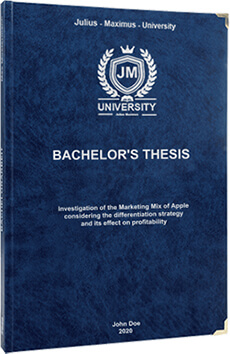
Thesis: Definition and Meaning
A thesis is written as part of your course requirements at university. The document is based on the author’s research and findings and is used to show mastery of the profession in question. It is also a gauge of the student’s ability to plan, analyze, report and present a project. A bachelor’s thesis is usually written in the culmination of a bachelor’s program while the master’s thesis is written at the culmination of a master’s course. Both papers should be original documents written under the direction of the faculty advisor.
A thesis paper could be anything between 40 and 80 pages without counting the bibliography section. You are required to write your thesis in the last year of your course. Depending on the university policy and faculty, it may take about two semesters to complete your document.
Printing Your Thesis With BachelorPrint
- High-quality bindings with customizable embossing
- 3D live preview to check your work before ordering
- Free express delivery
Configure your binding now!
The Thesis Title

If you write a thesis, the first thing you have to think about is the thesis title. The thesis title is the first thing the readers will come in contact with regardin your thesis. Therefore the audience should already get a brief insight of your thesis through the thesis title.
It is important that you find a thesis title that you are interested in. Furthermore the thesis title should be brief because too many words can dishearten some readers.
There is also a possibility to structure the thesis title as a question. For capturing the attention of the reader, the question must reflect the tone of the paper and predict content, so readers are not left wondering what the paper is about.
The main components of a thesis title are:
- Area of Interest
- Internal Consistency
- Formatting
Every thesis title is as different as the research it describes. The components mentioned above are only some fundamental factors every thesis title includes.
There are some mistakes which easily can be done like too much words or jagon. To avoid these mistakes you have to focus on the following principles:
- purpose of the study
- scope of the study
- techniques used for the study
- tone of the study
Would you like to know more about finding the perfect thesis title for your thesis? The following article will help you to find a suitable thesis title. This way:
Table of Contents

The table of contents is an important part of your academic thesis. It shows how your paper is organised. The table of contents shows the chapters, sections and their page numbers. To guarantee that your table of contents is formatted accurately, you should complete it at the end of your paper.
Although every table of contents looks different because it depends on your academic field, there is a general order of how it should look like approximately:
1. Title Page
2. Copyright / Statement of Originality
3. Abstract
4. Acknowledgement, Dedication and Preface (optional)
5. Table of Contents
6. List of Figures/Tables/Illustrations
7. Chapters
8. Appendices
9. Endnotes (depending on your formatting)
10. Bibliography / References
Consistancy and accuracy is the main key for writing a table of contents for your thesis. If you are using subheadings in one chapter, you have to use them in all of your chapters. Furthermore the page numbers must match the pages of your thesis.
In Microsoft Word you have the possibility to create a table of contents automatically.
You would like to know more about creating a table of contents for your thesis? The following article gives you more information about table of contents. This way:
Acknowledgement for thesis

There are many people who help you during writing your thesis. In the acknowledgement for thesis you show your appreciation to all of these people, institutions and perhaps companies. You don´t need to thank all people who helped you during writing your thesis. It is up to you who you mention in your acknowledgement.
Note that the acknowledgement for thesis is not a mandatory part of your thesis. If you want to include an acknowledgement in your thesis, it needs to be as professional as the thesis itself.
An acknowledgement for thesis has to be formal which means you should avoid being to emotional. Usually you do not use a first person voice in academic papers, but in the acknowledgement it is possible.
In the acknowledgement for thesis, you start with the most important person of your study. The length of your acknowledgement depends on how many people you want to thank. There is no standart length. Nevertheless you should keep it as short as possible.
Here are some good samples:
- I would like to express my gratitude to my main supervisor, Michael Brown, who guided me throughout this project. I would also like to thank my friends and family who supported me and offered deep insight into the study.
- I wish to acknowledge the help provided by the technical and support staff in the Economics department of the University of London. I would also like to show my deep appreciation to my supervisors who helped me finalize my project.
Would you like to know more about writing the perfect acknowledgement for thesis? The following article shows you how to write a good acknowledgement for thesis. This way:
FAQs
The thesis formatting can be broken down into 3 main parts.
Part 1: This part has your cover page, description page, table of contents and a list of figures and tables.
Part 2: This part is the body of your thesis. It will contain your introduction, results, and discussion.
Part 3: The last part simply contains your references and appendices.
The thesis title will frame what you’re going to be discussing in your paper. It’s important that the thesis title isn’t too vague, but also not too long. Generally, 10–15 words is the perfect amount to work with. Readers should be able to read your title and immediately have an idea of what your thesis is about, what the formatting will look like and the tone that your thesis will take.
The thesis introduction should draw the reader in and evoke interest. It needs to describe the purpose or objectives of your thesis and mention the methods that you used to conduct your research. If you’re having difficulty writing your thesis introduction, try to write some of the body paragraphs before coming back to the introduction.
The thesis statement provides a summary of the main idea of the paper in 1–2 sentences. It tells the reader about your interpretation of the subject/issue and sets the tone for the paper. The thesis statement is usually placed towards the end of the introduction.
You should finalize your table of contents once you’ve completed your thesis. However, it’s a good idea to draw up a rough plan for your table of contents whilst you’re creating your thesis format. As you write your thesis and alter the structure, you can add and remove sections from your ‘mock’ table of contents.
